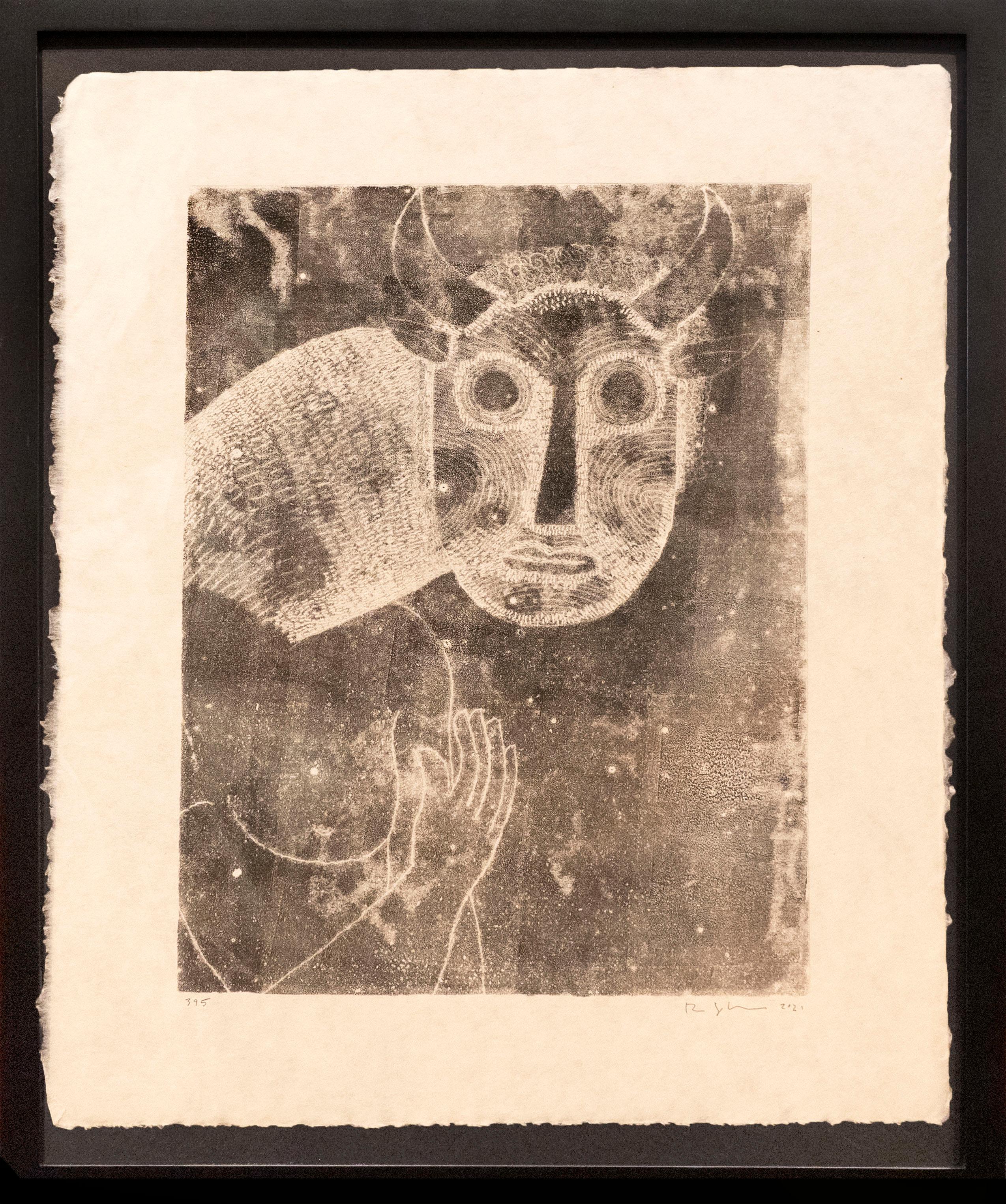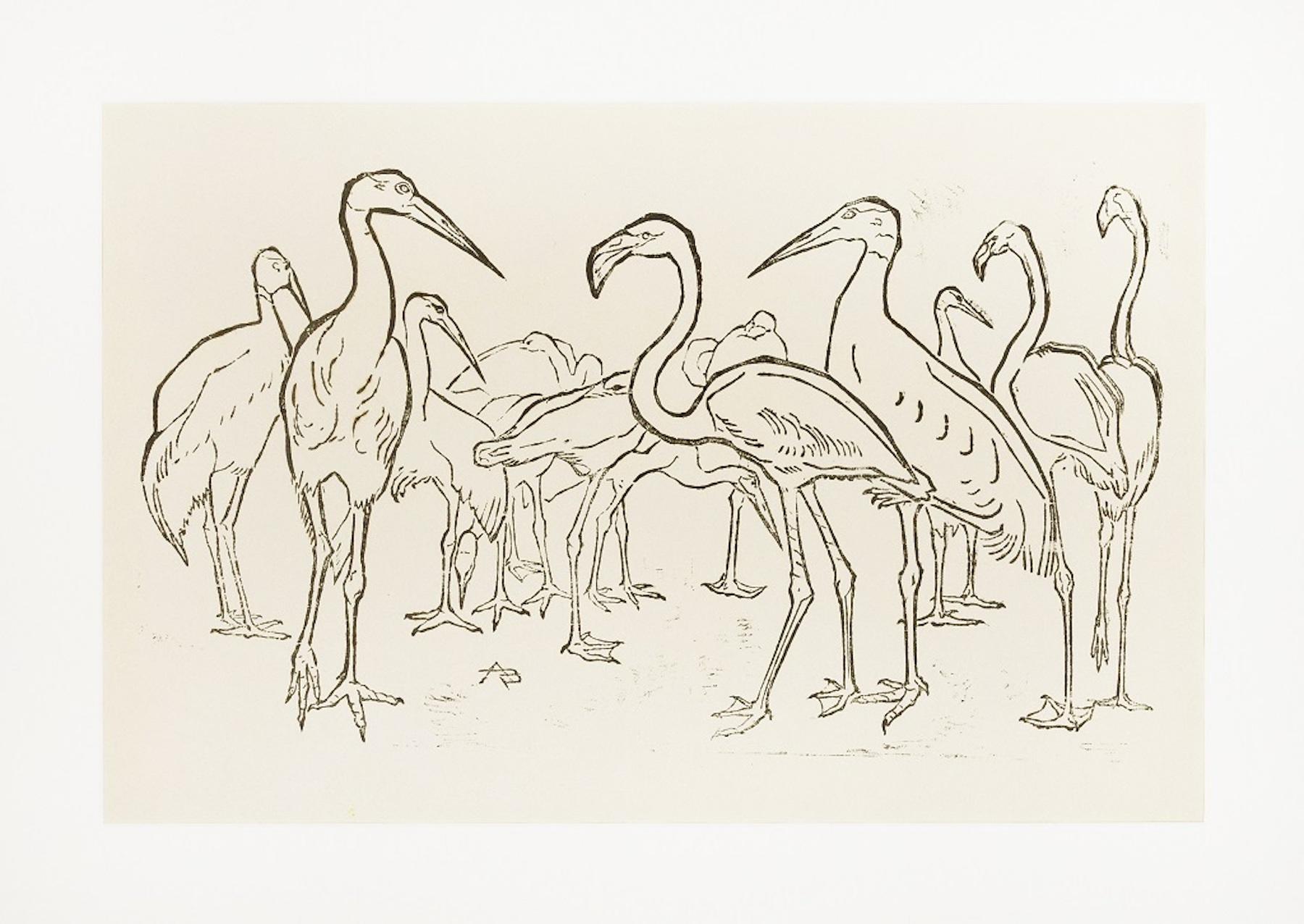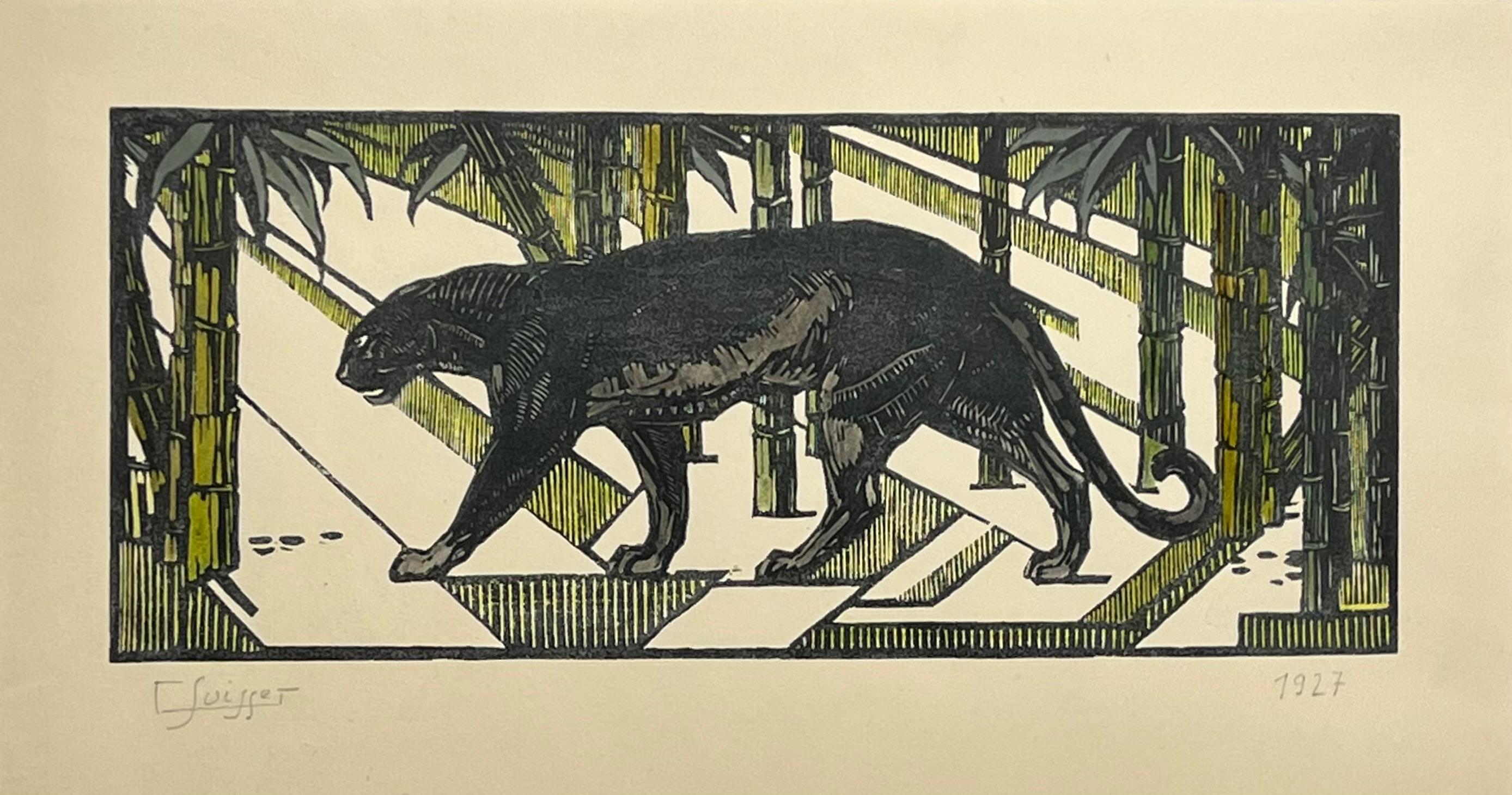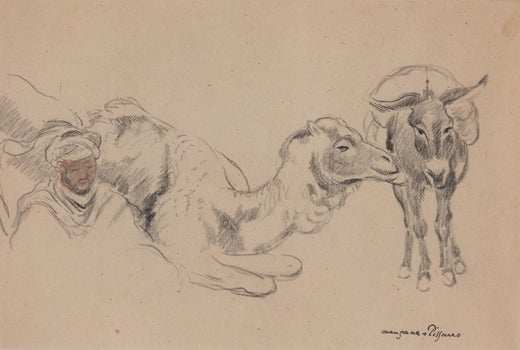Georges Henri Manzana PissarroLes cygnes by Georges Manzana Pissarro - Animal themed monotype circa 1920
circa 1920
About the Item
- Creator:Georges Henri Manzana Pissarro (French)
- Creation Year:circa 1920
- Dimensions:Height: 19.3 in (49 cm)Width: 24.81 in (63 cm)
- Medium:
- Movement & Style:
- Period:
- Condition:
- Gallery Location:London, GB
- Reference Number:1stDibs: LU261211193532
Georges Henri Manzana Pissarro
Georges-Henri Pissarro, better known as Manzana, was born in Louveciennes, the third of Camille Pissarro and Julie Vellay’s seven children.
He studied with his father from a very early age and, like Lucien — Camille and Julie's eldest son — he spent his formative years surrounded by distinguished artists of the Impressionist movement, such as Monet, Cézanne, Renoir and Gauguin, all of whom frequented the Pissarro home. At his father's side he learned not only to handle brush and pencil but also to observe and to love nature.
Thus steeped in tradition and subjected to these diverse influences, Manzana turned out to be a prolific and versatile artist, producing work in oil, pastel and watercolour. As a young man he adopted his father's purely Impressionist style and produced a series of landscapes around Pontoise and Eragny. However, around 1906 he progressed beyond that and went in search of other means of expression via the design of furniture and decorative objects. The influence of Gauguin's exotic native scenes from Tahiti and Martinique certainly contributed to the development of Manzana's Orientalism, which at this time began to manifest itself in some of his paintings by his experimenting with gold, silver and copper paint.
Like all the second generation Pissarro artists, Georges initially worked under an assumed name. In 1894 he adopted "Manzana,” the family name of his maternal grandmother, and it was not until 1910, out of respect to his then-deceased father, that he employed his own family name when signing his work.
During the early 1900s Manzana regularly exhibited Impressionist works at the Salon d'Automne and the Salon des Indépendants, as well as Durand Ruel and Druet in Paris. In 1907 he had his first exhibition of decorative works at Vollard, but it was in 1914 that he had the most important exhibition of his career at the Musée des Arts Décoratifs, where he exhibited 311 works including tapestries, carpets, furniture, glassware, decorative paintings, etchings and lithographs.
Manzana continued to exhibit his work regularly until the late 1930s, splitting his time between Les Andelys and Paris, although spending several summers at Pont Aven in Brittany, where the local costume and lifestyle inspired a series of paintings in the 1930s. At the declaration of war in 1939, he moved with his family to Casablanca, where he stayed until 1947.
Manzana was married and widowed three times. He spent the last years of his life with Félix, his youngest son who was also an accomplished artist, in Menton, returning to the Impressionist tradition and painting the local landscape.
(Biography provided by Stern Pissarro Gallery)
- ShippingRetrieving quote...Ships From: London, United Kingdom
- Return PolicyA return for this item may be initiated within 7 days of delivery.
- Procede by Georges Manzana Pissarro - Monotype of a birdBy Georges Henri Manzana PissarroLocated in London, GBProcede by Georges Manzana Pissarro (1871-1961) Coloured monotype with gold, silver and pencil 24 x 30 cm (9¹/₂ x 11³/₄ inches) Signed lower right, Manzana Artist biogaphy Like all ...Category
20th Century Post-Impressionist Animal Prints
MaterialsGold, Silver
- The Nomads by Orovida Pissarro - EtchingBy Orovida PissarroLocated in London, GBThe Nomads by Orovida Pissarro (1893-1968) Etching and aquatint, final state 21/42 27 x 41 cm (10 ⁵/₈ x 16 ¹/₈ inches) Signed, Orovida, and dated 1925 Orovida was a gifted printmake...Category
1920s Art Deco Figurative Prints
MaterialsEtching
- Mare and Foal by Orovida Pissarro - Etching PrintBy Orovida PissarroLocated in London, GBSOLD UNFRAMED Mare and Foal by Orovida Pissarro (1893 - 1968) Etching 15.6 x 20.7 cm (6 ¹/₈ x 8 ¹/₈ inches) Artist's Biography Orovida Camille Pissarro, Lucien and Esther Pissarr...Category
20th Century Figurative Prints
MaterialsEtching
- Man & Beast by Orovida Pissarro - EtchingBy Orovida PissarroLocated in London, GB*UK BUYERS WILL PAY AN ADDITIONAL 20% VAT ON TOP OF THE ABOVE PRICE Man & Beast by Orovida Pissarro (1893-1968) Etching 27 x 22 cm (10 ⁵/₈ x 8 ⁵/₈ inches) Signed and dated lower right, orovida 1924 Inscribed lower left, Final state no 12/40 and titled lower centre Artist biography: Orovida Camille Pissarro, Lucien and Esther Pissarro’s only child, was the first woman in the Pissarro family as well as the first of her generation to become an artist. Born in Epping, England in 1893, she lived and worked predominantly in London where she became a prominent member of several British arts clubs and societies. She first learned to paint in the Impressionist style of her father, but after a brief period of formal study with Walter Sickert in 1913 she renounced formal art schooling. Throughout her career, Orovida always remained outside of any mainstream British art movements. Much to Lucien's disappointment she soon turned away from naturalistic painting and developed her own unusual style combining elements of Japanese, Chinese, Persian and Indian art. Her rejection of Impressionism, which for the Pissarro family had become a way of life, together with the simultaneous decision to drop her famous last name and simply use Orovida as a ‘nom de peintre’, reflected a deep desire for independence and distance from the weight of the family legacy. Orovida's most distinctive and notable works were produced from the period of 1919 to 1939 using her own homemade egg tempera applied in thin, delicate washes to silk, linen or paper and sometimes embellished with brocade borders. These elegant and richly decorative works generally depict Eastern, Asian and African subjects, such as Mongolian horse...Category
1920s Post-Impressionist Animal Prints
MaterialsEtching
- The Hunting Prince by Orovida Pissarro - EtchingBy Orovida PissarroLocated in London, GBThe Hunting Prince by Orovida Pissarro (1893 - 1968) Etching 15 x 20 cm (5 ⅞ x 7 ⅞ inches) Signed and dated lower right Orovida 1926 Inscribed lower left Trial proof no.14 and titled lower middle Provenance: Private collection, Europe Artist biography: Orovida Camille Pissarro, Lucien and Esther Pissarro’s only child, was the first woman in the Pissarro family as well as the first of her generation to become an artist. Born in Epping, England in 1893, she lived and worked predominantly in London where she became a prominent member of several British arts clubs and societies. She first learned to paint in the Impressionist style of her father, but after a brief period of formal study with Walter Sickert in 1913 she renounced formal art schooling. Throughout her career, Orovida always remained outside of any mainstream British art movements. Much to Lucien's disappointment she soon turned away from naturalistic painting and developed her own unusual style combining elements of Japanese, Chinese, Persian and Indian art. Her rejection of Impressionism, which for the Pissarro family had become a way of life, together with the simultaneous decision to drop her famous last name and simply use Orovida as a ‘nom de peintre’, reflected a deep desire for independence and distance from the weight of the family legacy. Orovida's most distinctive and notable works were produced from the period of 1919 to 1939 using her own homemade egg tempera applied in thin, delicate washes to silk, linen or paper and sometimes embellished with brocade borders. These elegant and richly decorative works generally depict Eastern, Asian and African subjects...Category
1920s Animal Prints
MaterialsEtching
- Horse Pulling Hay Cart by Félix Pissarro - Animal etchingBy Félix PissarroLocated in London, GBHorse Pulling Hay Cart by Félix Pissarro (1874-1897) Etching 19.5 x 15 cm (7 ⅝ x 5 ⅞ inches) Exhibition London, Stern Pissarro Gallery, Camille Pissarro & hi...Category
1890s Post-Impressionist Animal Prints
MaterialsEtching
- Minotaur 395By Richard DownsLocated in Nashville, TNImage Size: 16 x 12 in "Minotaur 395" is an ink cognate print, or "ghost print," on archival Japanese paper by artist Richard Downs. About the Artist: Richard Downs transfigures s...Category
2010s Contemporary Figurative Prints
MaterialsInk, Archival Paper, Monotype
- She Loves Luna and Sombra monotype by Melanie Yazzie, Navajo, dog, girlBy Melanie YazzieLocated in Santa Fe, NMShe Loves Luna and Sombra monotype by Melanie Yazzie, Navajo, dog, girlCategory
Early 2000s Contemporary Animal Prints
MaterialsMonotype
- Storks and Flamingos - Original Woodcut by Unknown French ArtistLocated in Roma, ITStorks And Flamingos is an impressive original black and white xylograph on paper realized by Anonymous artist in the XX Century. Including white cardboard passepartout, cm 49 x 69...Category
Early 20th Century Modern Animal Prints
MaterialsWoodcut, Watercolor
- Art deco handcolored woodcut on paper - Walking black panther by Gaston SuisseLocated in Carouge GE, GEGaston Suisse (1896-1988) Panthère noire dans les bambous, 1927 Gravure sur bois, sur papier Velin de Van Gelder. Rehaussé aux lavis d’encre de Chine par l’artiste Signé en bas à gauche et daté 1927 en bas à droite Black panther in a forest of bamboos, 1927 A handcolored woodcut on Velin de Van Gelder paper Signed and dated 1927 Bibliographie /Literature Gaston Suisse, splendeur du laque art déco. Emmanuel Bréon. Somogy Éditions d'art, Paris 2013, reproduite page 105 (un autre exemplaire reproduit) The artist made a wood engraving of which he made about twenty prints himself. These proofs were not marketed as is, Gaston Suisse reworked each of the proofs using Indian ink washes in order to obtain different effects for each proof, which are thus unique original works. Born in 1896 in a family of artists, his father Georges was a close friend of Siegfried Bing and a great lover of Japanese art and a bibliophile. He passed his taste for art to his son whom he often took to draw at the Botanic Garden . Around 1910, Gaston Suisse, who hasn't entered yet the artistic school, met Paul Jouve, then 18 years his elder, who was already famous. In 1911, at the age of 17, he entered the National School of Decorative Art where he followed the teachings of Paul Renouard. Thanks to his knowledge and taste for the Japanese art, he chose lacquer painting as his specialty. His practice of this noble and demanding subject were so much appreciated that he was awarded with two gold medals in 1913 and 1914. Mobilized during the war , he joined the army and go in Salonika where he found his friend Jouve. In 1918, he finished his studies at the School of Applied Arts in order to perfect his training. He learned in particular the techniques of gilding and oxidation of metals. The first productions of Gaston Suisse, furniture and objects in lacquer with geometrical patterns, were an instant success and Suisse was appointed as member of Salon d'Automne in 1924, the very year of his first exhibition. Considered as an artist-decorator, his sincere and deep friendship with Jouve linked him in parallel with the groups of the animaliers of the Jardin des Plantes and became a close friend of Edouard-Marcel Sandoz. When travelling to Maghreb and Middle-East between 1923 and 1925, he produced numerous drawings representing antelopes, apes and fennec foxes...Category
1920s Art Deco Animal Prints
MaterialsIndia Ink, Woodcut
- Rockwell Kent, Four Bookplates (on one sheet)By Rockwell KentLocated in New York, NYProof sheet with four wood engraved book plates by Rockwell Kent. Possibly for a book on this subject published in 1937. There are pencil numbers under each image that probably indic...Category
Early 20th Century Art Deco Figurative Prints
MaterialsWoodcut
- "Cinderella" framed antique 1927 signed and dated etching by artist Louis IcartBy Louis IcartLocated in Boca Raton, FL"Cinderella" framed antique 1927 etching of Cinderella and her dog by artist Louis Icart. Signed Louis Icart on lower right. Inscribed "Edité par les Artistes Modernes, 5 rue Scribe ...Category
1920s Art Deco Figurative Prints
MaterialsEtching





